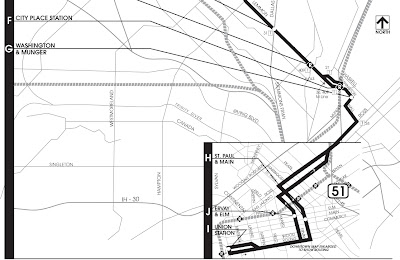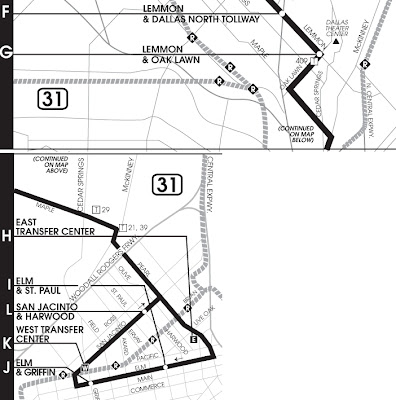The impetus is the opening of the Irving branch of the Orange Line, the Rowlett extension of the Blue Line and a park and ride/transfer center near Legacy Park in Plano. It makes sense to change some bus routes in an effort to maximize efficiency. The bus system as is was conceived without a rail component. However, adding to the issue is that DART's finances aren't in the best of shape, partly due to the economy and partly due to increasing amounts of debt to build the rail system. This has caused the planners to look at areas of the system that aren't impacted by the new openings to try and find cost savings. I went to speak specifically for the 31 route, since its rerouting would negatively impact my wife.
Staff's proposal for service in this sector is to shorten the 51 before it enters the Oak Lawn and Uptown areas and making it a rail feeder further north. They would then move the 31 onto the Lemmon and East Dallas portions of the current 51. This change would leave the 409 crosstown route as the only bus service on the lower portion of Oak Lawn and the 29 as the only route on Maple.
Here are the maps of the routes in question taken from DART's website.
 |
| This is the 51. What is shown would no longer be in existence if the service change proposal is passed without alteration. Instead, the 31 would be rerouted to the above streets. |
 |
| The 31 as it exists today. Should the service change pass unchanged, this would no longer exist, as would any local bus service on the lower part of Oak Lawn. |
Because urban neighborhoods contain denser residential, office and shopping concentrations than their suburban counterparts, they need transportation services that are denser as well. For these urban areas to maintain or grow their vitality, other forms of transportation, usually in the form of walking, transit and bicycles, must be made possible. These changes could have a harmful impact in creating the vibrancy needed.
In my view, this should be how DART planners approach bus service in the urban core. The urban neighborhoods must be identified, then their streets prioritized for service. In Dallas, the primary urban neighborhoods near the core are Downtown, Uptown, Victory, Deep Ellum, Knox-Henderson, Oak Lawn, the Cedars and the Design District. Of those Uptown has one fringe station (Cityplace), Victory has one fringe station (Victory), Deep Ellum has one fringe station (the Deep Ellum named station is actually several blocks away from the actual border of Deep Ellum. Baylor Station actually borders Deep Ellum) and the Cedars has one, but it is a neighborhood without critical mass and therefore underutilized as an urban station. Only Downtown has any sort of quality rail stops.
Once this problem is identified, the buses must be routed on those main streets. Even in downtown, with decent rail service, the Elm/Commerce corridor is teeming with bus routes. Over 15 run on each street in addition to the rail system. In the Oak Lawn area, the namesake street is the "Main Street" and therefore requires the attention. Since these are all close in neighborhoods, all of them should connect to one another and downtown.
Ideally these primary streets should have multiple routes, similar to the Elm/Commerce section of downtown. As is currently the case for Oak Lawn, you can board a bus and go to: east and central Downtown, Parkland Hospital, near Love Field and NW Dallas, Uptown, Cityplace, Old East Dallas and Fair Park.
With the budget crunch, the idea that duplicate routes need to be cut will have an adverse effect on the circulation of the urban area. The ability to go many places at your doorstep without a transfer is what should separate the urban transit service from the suburban. Sadly, DART is looking at all areas of the bus system from a suburban standpoint.
The other idea lost in this change is that getting rid of duplication also has the side effect of reducing capacity. Let's assume that no one stops taking transit and everyone transfers. Big if, but it will illustrate the point. If every one of those riders on the Oak Lawn portion of the 31 switch to the 409, then the 409, without an increase in frequency, will be fuller. That isn't always a bad deal for DART, but if the 409 is at 70 percent capacity during rush hour and the 31 is at 80 percent, this section of Oak Lawn will quickly get crowded.
In defense of the planners, that would be exactly the scenario. Those folks going from downtown to destinations beyond Lemmon and Oak Lawn, will not be affected by the route change. However, they will be facing a longer ride. Since the WTC is the central point in the DART system, any bus that begins away from there will likely require extra time for passengers to get to that bus. In this case, passengers will need to begin at Union Station. That may not be a bad idea if you are coming from the southern portions of the Blue or Red Lines. But anywhere else in the rail system or any other bus will add extra time just to get to the new bus route.
Now, if both buses currently leave the starting point at the same time, the 31 riders will get to Lemmon and Oak Lawn in 12 minutes. Riders on the 51 will get there in 22 minutes. So not only will there be an increase in times to get to the bus for most riders, there will also be an increase in time for all passengers going beyond Oak Lawn and Lemmon.
Remember what I have said previously about how to do transit right. Get people from point A to point B and do it efficiently, whether that is measured in time, money, minimizing transfers, etc. This service change does the first, but regresses considerably on the second. An increase in time, an increase in transfers, longer headways and lower capacity are some some of the negative side effects. The positive is lower operational costs. If the bus system was discontinued, lower costs would be accomplished too, but obviously that wouldn't be efficient nor optimal.
1 comment:
Since you said there are other routes besides the 31, can you talk about those changes?
Post a Comment